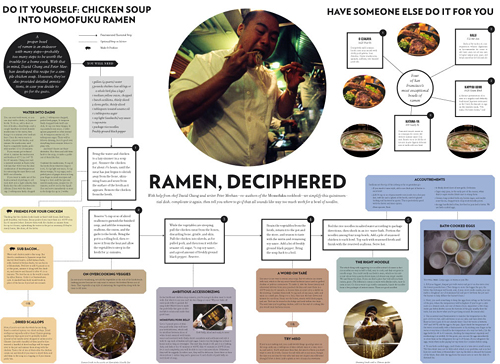
The San Francisco-based publishing hub McSweeney's has always liked packaging. A clever design sensibility characterizes the brand as much as its playful literary ethos. Issue #17 of the quarterly was a stack of mail. Half a year later, another (#19) came in a cigar box. Unleashed on December 8th, the latest installment (#33) assumes the guise of a daily newspaper -- albeit a one-time only assemblage of 300-something pages of articles, cartoons, and full-color photographs -- including a 112-page magazine, a 15" by 22" broadsheet, several pull-out posters, and nearly 100 pages of book reviews -- with contributions by some of the most lauded writers, artists, and photographers in the game. Panorama, as the issue has been dubbed, was conceived as a vivid re-imagination of the printed newspaper, a medium that has seen much hardship in recent years -- to the point where, as daily newspapers shed staff members and fold unceremoniously, some question the publication's relevance as a provider of valuable and timely content. With its long procession of dazzling bylines (Stephen King, George Saunders, Michael Chabon, Miranda July, Art Spiegelman, and so on) and an immensely high production value, Panorama will not be confused with any flimsy new-stand rags of which you might be familiar. I supposed that's part of what is amusing -- and compelling -- about the endeavor. Newspapers are disposable; with the exception of the Sunday New York Times, they're bought for coins, skimmed, and left on bus seats to flutter, drift, and decompose. Elevating the form to lofty heights -- even for one stand-alone issue -- makes a statement. One thing is for certain: with a ticket price of $16, no one will be using Panorama to line a hamster's cage.
This is, of course, a blog about food, and happily, Panorama's food section is 16 pages long, with articles about Ryan Farr's 58-step deconstruction of a helpless lamb carcass, a first-person from L.E. Leone on tackling roadkill, and a tutorial in homemade Andean spit-corn beer -- which looks fairly disgusting. In general, mildly repellent facets of food preparations and pleasures both common and unfamiliar enjoy rare moments in the spotlight alongside more universally appealing subjects -- like David Chang and Peter Meehan's complex guide to formulating the perfect bowl of ramen, a delight anyone without a pork problem can get behind.

I'm not interested in reporting on what in the food-verse Panorama has seen fit to report -- though that would be an suitably Internet-y concern. Anyone wanting to know the gritty and succulent details of the food section can just buy the newspaper, or read one of dozens of summaries floating around. What I am actually interested in is how Panorama's food pages might potentially epitomize a new ideal for the framing of food stories, recipes, and related visual content in print, and how that could possibly trickle down to the under-funded and under-valued realm of real daily newspapers. In the online editions of daily papers, dining sections bubble over with instructional videos, picture galleries, and blogs. To use the New York Times as an example, last week's Dining & Wine featured a slide-show on holiday cocktails, Bittman tossing together some turkey curry in a post-Thanksgiving-themed video, and in the Diner's Journal blog, an entry discussing San Francisco's newest tiki bar, Smuggler's Cove -- which incidentally looks like a place to avoid. Background context and opportunities for further research are mere clicks away courtesy of blue-hued hyperlinks speckling each swath of text. I can't exactly remember the last time I read the print version of a food story from either the Chronicle or the New York Times, but as I recall, nothing about the content -- fairly short articles, bullet points in boxes, a few color photographs, ads, and the odd graphic, laid out in columns -- tends to speak dramatically to the particulars of the form -- large folds of paper.
Online editions of newspapers post news of an event within seconds of it happening, and rich multimedia offerings can provide color and a breadth of information print cannot. However, that advantage is less clear when it comes to reporting food news, sharing traditions, and reviewing restaurants, for example. Yes, troves of easily accessible recipes online and visual guides demonstrating techniques have value, but they don't render the print alternatives obsolete.